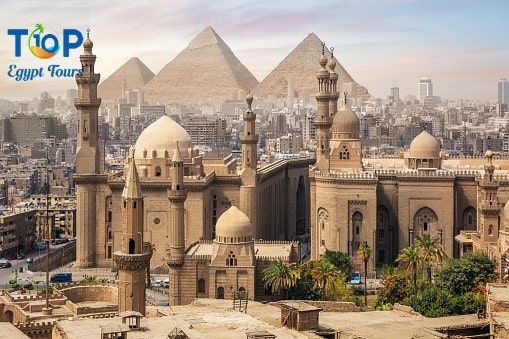Nestled along the banks of the majestic Nile River, Cairo, the capital city of Egypt, is a treasure trove of history and culture. While the bustling streets and iconic pyramids often steal the spotlight, there lies a hidden gem within the heart of the city – the historic neighborhoods of Islamic Cairo. In this article, we will embark on a journey through time to explore the timeless beauty that resides within the narrow alleyways and ancient structures of these enchanting districts.
1.Khan El Khalili: A Souk Steeped in History
The heartbeat of Islamic Cairo, Khan El Khalili is a vibrant and bustling marketplace that has stood the test of time. Dating back to the 14th century, this historic souk is a labyrinth of narrow alleys adorned with colorful stalls, offering a mesmerizing array of goods from traditional spices and perfumes to exquisite handmade crafts. As you weave through the labyrinthine paths, you’ll feel the echoes of centuries past, transporting you to an era where trade and commerce thrived.
2. Al-Muizz Street
Al-Moaaz Street, also known as Al-Muizz Street or Al-Moez Ldin Allah Al Fatimi Street, is a historic street located in Islamic Cairo, Egypt. This street is renowned for its wealth of medieval architectural treasures, representing the cultural and historical richness of Cairo.
Al-Moaaz Street is a living museum of Egypt’s diverse history. As you wander through its lanes, you’ll encounter monuments that bear witness to the various dynasties that have shaped the country. Each structure narrates a unique story, from the Fatimid era to the Mamluk and Ottoman periods, offering a comprehensive overview of Cairo’s historical evolution.
3. Bab Zuweila: A Gateway to Cairo’s Rich History
Pass through Bab Zuweila, one of the historic gates of Cairo’s ancient city walls, and feel the weight of centuries beneath your feet. This monumental gate, constructed in the 11th century, has witnessed the rise and fall of empires, the ebb and flow of trade, and the passage of countless souls. Its imposing presence serves as a reminder of Cairo’s rich and enduring history.
4. Bayt Al-Suhaymi: A Glimpse into Family Life
Step back in time with a visit to Bayt Al-Suhaymi, a beautifully preserved 17th-century house offering a rare glimpse into the domestic life of a wealthy Cairo family. Wander through intricately decorated rooms, experience traditional furnishings, and find peace in the tranquil courtyard.
5. Al-Darb Al-Ahmar
Al-Darb Al-Ahmar is one of the oldest and most vibrant neighborhoods in Islamic Cairo. Its name translates to “The Red Road,” referring to the red-brick buildings that line its streets. The neighborhood is home to several historic landmarks, including the Al-Azhar Mosque and Madrasa (Islamic college), which dates back to the 14th century. The area is also famous for its bustling markets, traditional cafes, and street art.
6. Darb al-Khushus Darb al-Khushus
Is a historic district located east of Al-Muizz Street. The area is named after a medieval aqueduct that once carried water from the Nile to Cairo’s citadel. Today, Darb al-Khushus is home to several historic landmarks, including the Sultan Hassan Mosque and Madrasa, which was built in 1361 CE by Sultan Hassan ibn Muhammad ibn Qalawun. The area also features several traditional houses and courtyards that have been restored and transformed into boutique hotels and cafes.
7.Al-Azhar Mosque
Al-Azhar Mosque, founded in 970 AD by the Fatimid Caliphate, holds the prestigious title of being one of the oldest continuously operating educational institutions in the world. Initially established as a center for Sunni learning, it has played a pivotal role in shaping Islamic scholarship and theology over the centuries. Its historical significance extends beyond its religious role, making it a cornerstone of Egypt’s cultural legacy.
8. Sultan Hassan Mosque: A Masterpiece of Mamluk Architecture
Sultan Hassan Mosque, a masterpiece of Mamluk architecture. Constructed in the 14th century, the mosque’s imposing grandeur and intricate details are a testament to the architectural prowess of the Mamluk era. Its soaring minarets, vast interior courtyard, and elaborate marble carvings will leave you in awe.
9. Ibn Tulun Mosque
The Ibn Tulun Mosque, commissioned by Ahmad ibn Tulun in the 9th century, is an architectural masterpiece that reflects the rich heritage of Islamic art. Its distinctive design features include a vast courtyard, a minaret with an external spiral staircase, and intricately decorated interiors. The use of pointed arches, domes, and ornate detailing showcases the elegance of Tulunid architecture.
10.Al-Hakim Mosque
The mosque was built in 1005 AD by the Fatimid caliph Al-Hakim bi-Amr Allah. The caliph was a controversial figure, but he was also a patron of the arts and sciences. Al-Hazim Mosque is a testament to his commitment to beauty and craftsmanship.
The mosque’s exterior is characterized by its simple yet elegant design. The walls are made of red brick and white marble, and they are decorated with intricate geometric patterns. The mosque’s main entrance is topped by a pointed arch, which is a characteristic feature of Fatimid architecture.
As we conclude our journey through the historic neighborhoods of Islamic Cairo, we invite you to immerse yourself in the timeless beauty that awaits around every corner. With Top Ten Egypt Tours, your exploration of Egypt’s hidden gems becomes an unforgettable adventure, where history, culture, and beauty converge to create memories that last a lifetime. Book your tour now and let the wonders of Cairo unfold before you.
Browse our complete list of Egypt tours.



Comment (0)